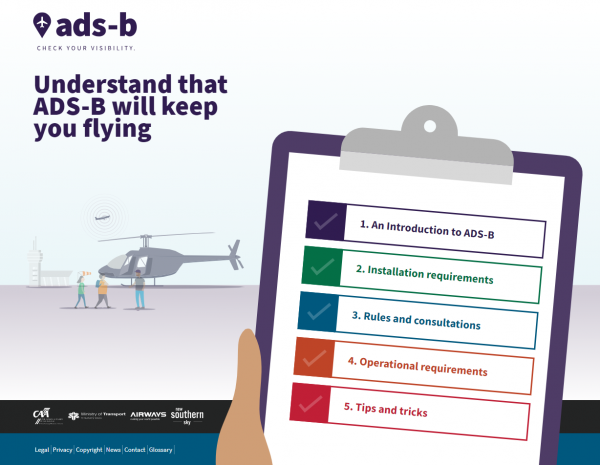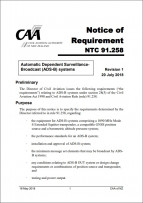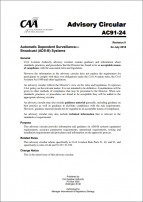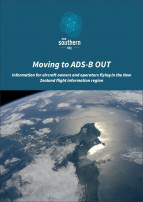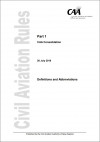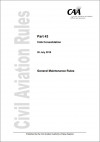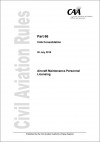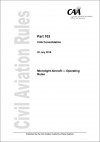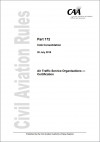Surveillance
New Southern Sky and Surveillance
A crucial element of New Southern Sky is the replacement of ground-based radar technology with a modern, satellite-based system for surveillance.
New ADS-B Website Released! Don't get left in the hangar... equip with ADS-B to keep flying
The Civil Aviation Authority (CAA) is requiring ADS-B OUT in all transponder mandatory controlled airspace from 31 December 2022. As the New Zealand aviation system moves towards this new primary surveillance capability, you’re strongly encouraged to beat the queues, equip early and begin enjoying the benefits.
To help you with this transition, the CAA have created a new website specifically focussing on ADS-B and what it means for you. You’ll find the practical information, and helpful tips and tricks, at www.nss.govt.nz/adsb.
If you have any questions about ADS-B or how to equip, please don't hesistate tot get in touch with us on adsb@caa.govt.nz.
Major Milestone Achieved in July 2018
The first major regulatory milestone has been reached in the last week with the signing of the Rule, Notice and publishing of the AC with regard to ADS-B in the NZ FIR. The Future Surveillance project team has worked extremely hard to get this across the line and should be congratulated! So a very well done from everyone involved in the NSS Programme!
The recent timeline of events shows the achievements of the last month or so:
-
-
- 15 June 2018 - ADS-B Rules signed by the Associate Minister of Transport
- 20 July 2018 - ADS-B Notice signed by the Acting Director CAA
- 24 July 2018 - ADS-B Advisory Circular Published
-
The following documents will take you to the various links on the CAA website relating to this ADS-B Rule change.
ADS-B NoticeNTC91.258Signed by Acting Director Civil Aviation Authority, John Kay, on 20 July 2018. The Notice of Requirement contains information on the technical standards for ADS-B. |
ADS-B Advisory CircularAC91-24Advisory Circular AC91-24 Published on the 24th July 2018. |
Moving to ADS-B OUTInfo for the NZ FIRFurther information can be found in the following document 'Moving to ADS-B OUT - Information for aircraft owners and operators flying in the New Zealand flight information region'. |
|---|
If you have any questions regarding any of releases relating to ADS-B please send these to adsb@caa.govt.nz.
Rules that have Changed
While most of the technical information required to plan your transition to ADS-B is in the above documents, the specific rule changes affected by this include the following:
Part 1Amendment 54Definitions and Abbreviations |
Part 43Amendment 15General Maintenance Rules |
Part 66Amendment 6Aircraft Maintenance Personnel Licensing |
Part 91Amendment 31General Operating and Flight Rules |
Part 103Amendment 8Microlight Aircraft Operating Rules |
Part 172Amendment 13Air Traffic Service Organisations Certifications |
|---|
Additionally, the Future Surveillance project team have created several other supporting documents to assist with your search for the right information. You can follow the FAQ link below or have a look in the Resources Section of this website to see the full range of publications and resources available to you.
Frequently Asked Questions
January 2020
FAQs to help answer any burning questions you might have about the transition to ADS-B.
What is surveillance and what changes can you expect?
Surveillance involves monitoring the relative position of aircraft in flight so Air Traffic Control can ensure the right amount of separation to prevent collisions. The transition to satellite-based surveillance involves the use of Automatic Dependent Surveillance – Broadcast (ADS-B) technology. Using a combination of satellites, transponders and Global Navigation Satellite System (GNSS) receivers, aircraft will self-report their GNSS derived position. This means Air Traffic Control, a service provided in New Zealand by Airways New Zealand, can determine a more accurate position, enabling a more efficient traffic flow, more air traffic capacity and improved safety.
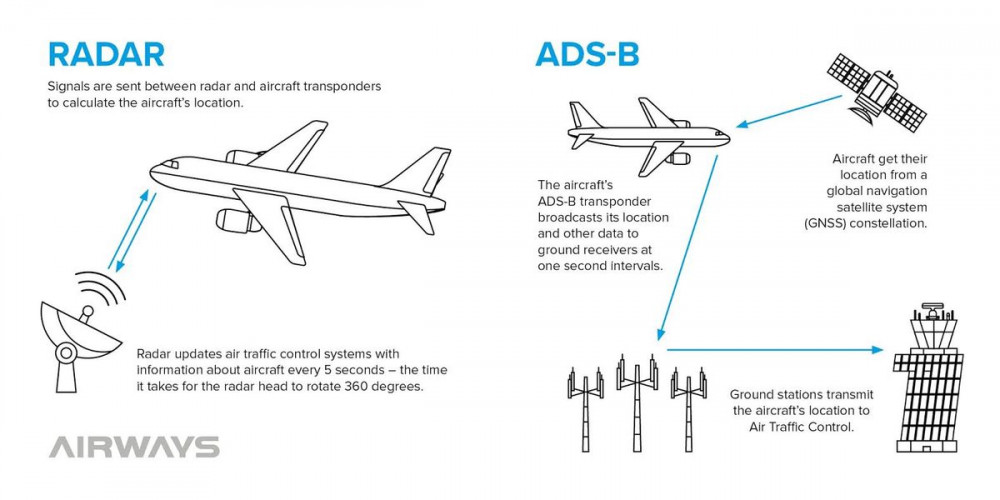
ADS-B will require equipment upgrades for aircraft and Air Traffic Control. New Southern Sky proposes that it will be introduced in a phased way. By the end of 2018, all aircraft flying above Flight Level 245 will need to have operational ADS-B. By the end of 2021, all aircraft flying in controlled airspace will require operational ADS-B. To make sure these changes happen smoothly, New Southern Sky will provide operators advance notice of new equipage requirements and guidance to help them make the right purchasing decisions. We’ll also be making sure that implementation of ADS-B aligns with the timeline for the introduction of Performance Based Navigation (PBN), which is another key and interdependent element of our programme.
If you have any questions regarding ADS-B please send these to adsb@caa.govt.nz.
Useful ADS-B Documents
ADS-B Frequently Asked Questions
Do you fly in controlled airspace?
Automatic Dependent Surveillance Broadcast Technology (ADS-B)
Since the mid-20th Century, New Zealand Air Traffic Management has relied on ground-based radar for surveillance. Replacing this technology with a modern, satellite-based system is a key part of New Southern Sky and is the system recommended by ICAO to replace ageing radar technology.
Using a combination of satellites, transponders and Global Navigation Satellite System (GNSS) receivers, ADS-B involves aircraft self-reporting their GNSS derived position. It is compatible with other surveillance systems and will enable increased air traffic system capacity by improving positional accuracy on air traffic control displays.
ADS-B Ground Receiver located above the beautiful Lake Wakatipu in the Southern Lakes District, NZ (Image courtesy of Airways NZ).
This means Air Traffic Control, a service provided in New Zealand by Airways New Zealand, can determine a more accurate position, enabling a more efficient traffic flow and improved safety. Airways is playing a leading role in the roll-out of ADS-B.
New Southern Sky proposes that ADS-B will be introduced in a phased way. By the end of 2018, all aircraft flying above Flight Level 245 will need to have operational ADS-B. By the end of 2021, all aircraft flying in controlled airspace will require operational ADS-B. New Zealand will use the 1090 MHz extended squitter (ES) ADS-B system. The Universal Access Transceiver system (UAT) used in the US will not be implemented here. It is important that operators don’t buy or fit UAT equipment because it is not compatible with the 1090 MHz system.
Current Technologies
Primary surveillance radar (PSR) transmits a radio signal that is reflected back to the radar by aircraft. The range and bearing of each aircraft detected is presented to the air traffic controller. PSR cannot identify aircraft, and does not rely on aircraft systems.
Secondary surveillance radar (SSR) not only detects and measures the range and bearing of aircraft, but also requests additional information from the aircraft itself, such as its identity and altitude.
Secondary surveillance radar relies on aircraft equipped with a mode A/C transponder, which replies to each interrogation signal by transmitting a response containing encoded identity and altitude data. Transponders are mandatory in New Zealand controlled airspace.
Multilateration (MLAT) is a more recent ground-based surveillance technique. A number of ground stations interrogate and receive replies from aircraft SSR transponders. The system calculates the position of the aircraft using the time difference between the arrival of a reply at four or more ground stations. Multilateration targets are typically updated once per second, compared with five-second intervals for radar targets. MLAT systems that cover broader areas are known as Wide Area Multilateration (WAM).
Automatic dependent surveillance-broadcast (ADS-B) transponders broadcast an aircraft’s position, altitude, velocity and other aircraft-derived data once or twice per second. Data received by ground stations is fed to air traffic control displays. This system provides controllers with richer and more accurate information, enabling more efficient traffic flow and improved safety. This system is known as ADS-B OUT.
Aircraft equipped with ADS-B IN can also receive ADS-B transmissions from other aircraft. ADS-B IN is expected to eventually replace the existing aircraft collision avoidance systems. Trials using ADS-B IN for specific types of self-separation, such as in-trail climb, are being conducted. Self-separation is unlikely to be adopted in New Zealand domestic airspace for many years.
Aviation surveillance today
In New Zealand, Airways provides surveillance coverage for most controlled en-route and terminal airspace using Monopulse Secondary Surveillance Radar (MSSR), with local areas of primary surveillance radar and multilateration.
- In the Auckland Oceanic Flight Information Region, communication is through Automatic Dependent Surveillance Contract (ADS-C).
- Surveillance contract (ADS-C4), Controller Pilot Data Link Communications (CPDLC) position reports, Flight Management Computer Waypoint Position.
- Reporting (FMC WPR)5 via data-link, and voice position reporting via HF radio and, in special circumstances, via satellite (SATVOICE).
- Multilateration is used for surface movement surveillance at Auckland International Airport.
- Wide-area multilateration coverage of the Queenstown area is being extended to cover most of Otago and Southland.
What's been happening
News and Updates
Newly released, New Southern Sky’s benefits evaluation report
We're delighted to announce the release of the New Southern Sky - Benefits Evalu…
